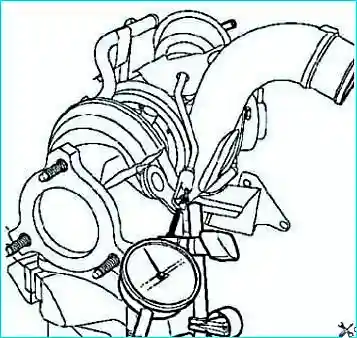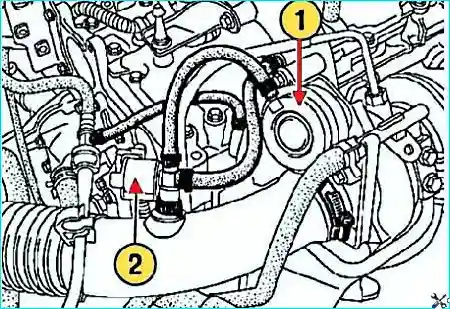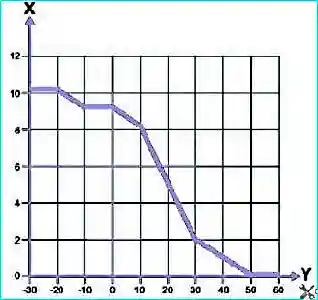The turbocharger pressure regulator rod cannot be adjusted.
Remove the turbocharger.
This test cannot be performed with the turbocharger installed.

Fig. 1. Checking the Fuel Pressure Regulator
Use a magnetic stand with an indicator, the leg of which is placed on the end of the boost pressure regulator valve actuator rod (as coaxially with the rod as possible) (Fig. 1).
Gradually apply pressure to the pressure regulator pneumatic actuator using a vacuum pump.
At 331 mbar, the rod stroke is 1 mm.
At 544 mbar, the rod stroke is 5 mm.
Boost Pressure Regulating Solenoid Valve

Fig. 2. Boost pressure control solenoid valve: 1 - pneumatic actuator, 2 - solenoid valve.
The boost pressure control solenoid valve is controlled by the solenoid valve in response to commands from the injection system ECU (Fig. 2).
The boost pressure control solenoid valve is controlled by the solenoid valve in response to commands from the injection system ECU.
In the initial position, the boost pressure control valve is closed and the solenoid valve is open.

Fig. 3. Boost Pressure Control Circuit
When open, the solenoid valve connects the turbocharger outlet (boost pressure) to the pneumatic actuator, so the boost pressure acts directly on the pneumatic actuator and the pressure regulator valve opens.
When the solenoid valve is controlled, the boost pressure signal (measured at the turbocharger outlet) is fed to the turbocharger input.
Consequently, the boost pressure is removed from the pneumatic actuator, and the pressure regulator valve closes.
After the engine starts, supply voltage is supplied to the solenoid valve, which is open in the initial position.
For a certain period of time, the duration of which depends on the coolant temperature, the boost pressure is limited and the engine crankshaft speed cannot exceed 2500 min–1.
This is necessary to allow the oil to reach turbocharger bearings.





